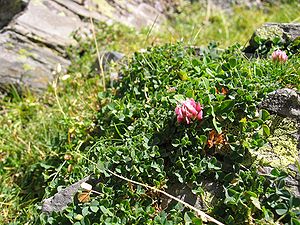Furious clover
| Furious clover | ||||||||||||
|---|---|---|---|---|---|---|---|---|---|---|---|---|

Razor clover ( Trifolium thalii ) in the Pyrenees |
||||||||||||
| Systematics | ||||||||||||
|
||||||||||||
| Scientific name | ||||||||||||
| Trifolium thalii | ||||||||||||
| Vill. |
The Rasige clover ( Trifolium thalii ), also called Alm-Klee referred to, is a plant art , which for the sub-family of papilionaceous (Faboideae) within the family of the Leguminosae part (Fabaceae or Leguminosae).
description
Vegetative characteristics
The Rasige Klee is a perennial, herbaceous plant that reaches heights between 4 and 10 centimeters. It forms dense lawns , with upright stems with a maximum height of 3 centimeters being rare. The leaves are divided into a petiole and a leaf blade. The leaf blade is triply pinnate. The pinna leaflets have seven to ten veins on.
Generative characteristics
The flowering period extends from July to August. The flower stalks are 1 to 1.5 millimeters long and are shorter than the calyx tube . The hermaphrodite flowers are zygomorphic and five-fold with a double flower envelope . The calyx teeth are only slightly unequal. The crown is of 6 to 10 mm about a half times as long as the cup, and has the typical shape of the butterfly bloom . The petals are white at first, then bright pink and light brown as they fade.
The species has chromosome number 2n = 16.
Possible confusion with other species
The white clover ( Trifolium repens ) is similar with branching, creeping and rooting stems - in contrast to the prostrate growth of the grassy clover.
distribution
The Rasige Klee is widespread in the Alps from the Dauphiné to Tyrol . It also grows in the Spanish mountains, in the Pyrenees , in the Apennines and in the Jura at altitudes of up to 2400 meters.
In Austria , this plant species occurs frequently to scattered, but only in Vorarlberg and Tyrol from the subalpine to alpine altitude . In Carinthia it is considered lost or extinct. In Germany it is only common in the south of Bavaria.
The limestone plant prefers fatty willows , storage corridors and snow soils as a location . It is a Poion alpinae association character, but also occurs in societies of the associations Caricion ferrugineae or Salicion herbaceae.
Locations and distribution in Central Europe
The grassy clover needs loamy or clayey, stony soil, which should be rich in nutrients and calcareous, and it has to be damp, even wet, at least at times.
It colonizes fatty pastures and cattle stores in higher elevations, but it also goes into snow valleys. It prefers heights between 1400 m and 2400 m, but locally it also rises to around 3000 m. In the Allgäu Alps, the species at the Rauheck summit in Bavaria reaches an altitude of 2380 m.
It occurs in the Alps and in the southern Swiss Jura ; in the alpine chains with calcareous rock it occurs scattered; otherwise it is rare in Central Europe .
Name declaration
The name Thals Klee as a translation of the scientific name Trifolium thalii honors the doctor and botanist Johannes Thal . Thal described a clover in his work "Sylva Hercynia", the first flora of the Harz Mountains from 1588, and named it "Trifolium montanum minus". Dominique Villars assumed in the first description of the grassy clover that it was about this species and gave it the name Trifolium thalii . However, Thal had meant a different species, because Trifolium thalii did not and does not occur in the Harz Mountains. Despite this mistake, the name must remain.
literature
- Muer, Angerer: Alpine Plants , Stuttgart 2004, ISBN 3-8001-3374-1
- Manfred A. Fischer , Wolfgang Adler, Karl Oswald: Excursion flora for Austria, Liechtenstein and South Tyrol. 2nd, improved and enlarged edition. State of Upper Austria, Biology Center of the Upper Austrian State Museums, Linz 2005, ISBN 3-85474-140-5 .
Individual evidence
- ↑ a b Erich Oberdorfer : Plant-sociological excursion flora for Germany and neighboring areas . 8th edition. Stuttgart, Verlag Eugen Ulmer, 2001. Page 594. ISBN 3-8001-3131-5
- ↑ a b c Dietmar Aichele, Heinz-Werner Schwegler: The flowering plants of Central Europe . 2nd Edition. tape 2 : Yew family to butterfly family . Franckh-Kosmos, Stuttgart 2000, ISBN 3-440-08048-X .
- ↑ Erhard Dörr, Wolfgang Lippert : Flora of the Allgäu and its surroundings. Volume 2, IHW, Eching 2004, ISBN 3-930167-61-1 , p. 130.
- ^ Gustav Hegi : Illustrated flora of Central Europe . Volume IV, part 3. Munich 1964, page 1307, footnote.
Web links
- Furious clover. In: FloraWeb.de.
- Furious clover . In: BiolFlor, the database of biological-ecological characteristics of the flora of Germany.
- Profile and distribution map for Bavaria . In: Botanical Information Hub of Bavaria .
- Trifolium thalii Vill. In: Info Flora , the national data and information center for Swiss flora . Retrieved November 17, 2015.
- Thomas Meyer: Data sheet with identification key and photos at Flora-de: Flora von Deutschland (old name of the website: Flowers in Swabia )